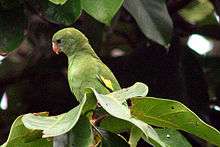White-winged parakeet
The white-winged parakeet (Brotogeris versicolurus), also called the canary-winged parakeet, is a small parrot native to the Amazon River basin from southeast Colombia to the River's mouth in Brazil. Caged birds have been released and the birds have established self-sustaining populations in Lima, Peru, the Los Angeles, San Francisco, California and Miami, Florida areas of the United States, and in Puerto Rico. Although feral birds are showing some recent declines as nesters in the United States, they seem to be doing well in their native habitat.
| White-winged parakeet | |
|---|---|
 | |
| near Leticia, Colombia | |
| Scientific classification | |
| Kingdom: | Animalia |
| Phylum: | Chordata |
| Class: | Aves |
| Order: | Psittaciformes |
| Family: | Psittacidae |
| Genus: | Brotogeris |
| Species: | B. versicolurus |
| Binomial name | |
| Brotogeris versicolurus (Muller, 1776) | |
Description
The white-winged parakeet is 22 cm in length, and is mostly green in color. It has a trailing yellow edge on its folded wings. Its most distinguished characteristic is the white wing patches most noticed when the bird is in flight. It is closely related to the yellow-chevroned parakeet, and the two have often been considered conspecific.
Behaviour
In captivity, these are charming birds that often have a close relationship with their human handlers. They enjoy spending time in physical contact with their owners, often riding around on shoulders or nesting in hair. They can have loud calls when not within sight of their "flock", but are generally quiet otherwise. They are adept climbers and enjoy a myriad of challenges. They are a very adaptable species of bird and are less picky than others about their available food options. They are not the strongest talkers, but are adept whistlers.
Food and feeding
The white-winged parakeet feeds mostly on fruit and seeds in its native habitat, and feral populations have adapted to take in blossoms and nectar. Feral birds will also come to bird feeders. Wild birds primarily use disturbed forest and forest clearings around settlements. It rarely uses deep tropical forest.
In captivity, a pelleted or seed diet are acceptable, supplemented with fresh fruits and vegetables and freshly sprouted seeds.
Breeding
The white-winged parakeet usually finds a hole in a tree to nest in. It may also take over termite tunnels and excavate them for their own purposes.
Clutches usually consist of three to five white eggs, which hatch after about 26 days of incubation. Young fledge between six and seven weeks of age, and are fully weaned at around nine weeks. After raising its young, all birds will form rather large communal roosts until the next breeding season.
References
- BirdLife International (2012). "Brotogeris versicolurus". IUCN Red List of Threatened Species. 2012. Retrieved 26 November 2013.CS1 maint: ref=harv (link)
- "National Geographic" Field Guide to the Birds of North America ISBN 0-7922-6877-6
- Handbook of the Birds of the World Vol 4, Josep del Hoyo editor, ISBN 84-87334-22-9
- "National Audubon Society" The Sibley Guide to Birds, by David Allen Sibley, ISBN 0-679-45122-6
External links
- History of Canary-winged Parakeets in the United States
- B. versicolurus-"White-winged Parakeet" photo gallery VIREO
- Photo-High Res; Article & synopsis arthurgrosset
